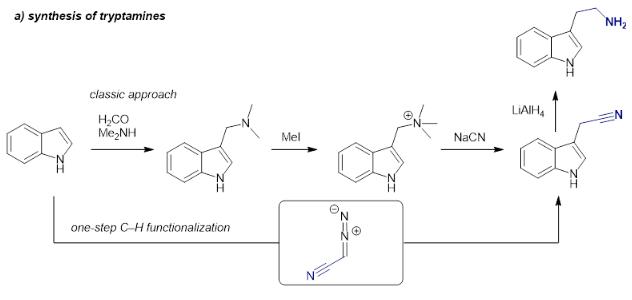2-(Indol-3-yl)ethylamin Chemische Eigenschaften,Einsatz,Produktion Methoden
R-S?tze Betriebsanweisung:
R20/21/22:Gesundheitssch?dlich beim Einatmen,Verschlucken und Berührung mit der Haut.
R36/37/38:Reizt die Augen, die Atmungsorgane und die Haut.
R41:Gefahr ernster Augensch?den.
R37/38:Reizt die Atmungsorgane und die Haut.
R22:Gesundheitssch?dlich beim Verschlucken.
S-S?tze Betriebsanweisung:
S24/25:Berührung mit den Augen und der Haut vermeiden.
S36/37/39:Bei der Arbeit geeignete Schutzkleidung,Schutzhandschuhe und Schutzbrille/Gesichtsschutz tragen.
S36:DE: Bei der Arbeit geeignete Schutzkleidung tragen.
S26:Bei Berührung mit den Augen sofort gründlich mit Wasser abspülen und Arzt konsultieren.
Beschreibung
Tryptamine is an indole alkaloid and intermediate in the biosynthesis of serotonin and the phytohormone melatonin in plants. It increases the levels of the terpenoid indole alkaloids ajmalicine, strictosidine, and catharanthine in cultures of
C. roseus. Tryptamine is also a product of tryptophan metabolism in mammals. Tryptamine derivatives have been synthetically produced as hallucinogenic drugs of abuse that act on the serotonergic system.
Chemische Eigenschaften
Tryptamine is a biogenic imine derived from the decarboxylation of tryptophan. It is a white to orange crystalline Powder, melting point 118°C (decomposition at 145-146°C). Soluble in ethanol and acetone, almost insoluble in ether, benzene, chloroform and water.
Verwenden
Tryptamine is a monoamine alkaloid found in plants. Tryptamine is commonly used in the preparation of biologically active compounds such as neurotransmitters and psychedelics.
synthetische
Tryptamine, a monoamine alkaloid containing an indole ring structure is derived by the decarboxylation of amino acid tryptophan.

The synthesis of tryptamines is typically conducted following a classic route starting with a Mannich reaction of an indole heterocycle, followed by quaternization of the amine, nucleophilic substitution with highly toxic cyanide and final reduction.
Definition
ChEBI: Tryptamine is an aminoalkylindole consisting of indole having a 2-aminoethyl group at the 3-position. It has a role as a human metabolite, a plant metabolite and a mouse metabolite. It is an aminoalkylindole, an indole alkaloid, an aralkylamino compound and a member of tryptamines. It is a conjugate base of a tryptaminium.
Allgemeine Beschreibung
Tryptamines which are usually found in plants, fungi, animals, etc. are categorized under the monoamine alkaloids class of compounds.
l?uterung methode
Crystallise tryptamine from *benzene, Et2O (m 114o) or pet ether (m 118o). It has UV: 222n 276, 282 and 291nm (EtOH) and max 226, 275, 281 and 290nm (HCl). [Beilstein 22 II 346, 22 III/IV 4319, 22/10 V 45.]
2-(Indol-3-yl)ethylamin Upstream-Materialien And Downstream Produkte
Upstream-Materialien
Downstream Produkte
Vinpocetin
1,2,3,4-TETRAHYDRO-9H-PYRIDO[3,4-B]INDOLE
N,N-Dimethyl-1H-indol-3-ethylamin
14,15-Dihydro-14-hydroxy-eburname-nin-14-carboxyls?ure-methylester,(3 alpha, 14 beta, 16 alpha),-
N-(p-Coumaroyl) Serotonin
1-TRIFLUOROMETHYL-2,3,4,9-TETRAHYDRO-1H-B-CARBOLINE
N-METHYL-N-ISOPROPYLTRYPTAMINE(MIPT)
Methyl-(19α,20α)-16,17-didehydro-19-methyloxayohimban-16-carboxylat
3-Ethylindole
2-cyano-N-[2-(1H-indol-3-yl)ethyl]acetamide
N-(2-INDOL-3-YLETHYL)(4-METHYLPHENYL)FORMAMIDE
N-(2-INDOL-3-YLETHYL)-3-PHENYLPROP-2-ENAMIDE

